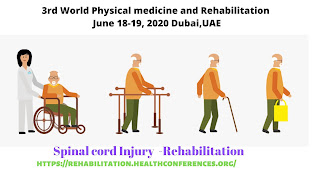Can Rehabilitation Help recover spinal Cord Injury?
Physical
medicine and rehabilitation: Physical medicine and rehabilitation
is a branch of medicine that intends to restore body functions of people that
they lost due to medical conditions or injury.
Rehabilitation helps in restoring several body functions, as well as
intestine and bladder issues, mastication and swallowing, issues in thinking or
reasoning, movement or quality, speech, and language.. Conditions that affect
the ability to function include brain disorders, such as stroke, multiple
sclerosis, or cerebral palsy, chronic pain including back and neck pain, major
bone or joint surgery, severe burns, or limb amputation, severe arthritis,
severe weakness after recovering from a serious illness, spinal cord injury or
brain injury.
Spinal
cord injury: it’s
the temporary or permanent damage to changes in the function of the spinal cord or
damage to any spinal cord nerves symptoms may include problems with muscular
weakness, coordination, spasms, stiff muscles, overactive reflexes. Whole-body sweating
or faint. Loss of sensation to touch and feel (Pins and needles). Problems with
urinary retention also some common sensations such as painful sensation,
leaking of stool and shortness of breath, problems in walking, Headache, Signs
of shock Pain and stiff of the back area of the body
Rehabilitation
for spinal cord injury: The ultimate goal while treatment is repairing
the damage created by injuries and also provides emotional, physical &
mental support and also education and resources
Acute
recovery: occupational
therapy plays an important role it includes a team of psychologists, social
workers, Physical therapist, physiatrists work under common goal for rehabilitation
there are almost four types :
·
Respiration
·
Functional electrical stimulation
·
Improving locomotors function
·
Provision
Other stages and treatments may include:
·
Sexual and fertility management
·
Neurologic functions
·
Spasticity management
·
Upper extremity function restoration
Post
rehabilitation recovery: it’s also the most important phase of treatment
this replaces most of the inpatient treatments use of assistive devices such as
wheelchairs which help in patient movement and another activates of daily life the patient living environment also modified by ramps and lifts instead of
staircase
Functional independence such as movability and daily
activates of life on their own rather than depending on others. Massage therapy
also included showing good results for a range of motion rehabilitation. Evaluation
of limb functions for future actions
Gait
training: Body
weight supported treadmill training used to reduce lower bone mass researches shown
daily this exercise for 10 mines shows significant results in reducing the loss of
bone mass. This is assisted with the latest robotic
assistive treadmill training it clued training walking speed assistance,
gait patterns, provide consistency of movements
Conclusion: physical therapy and rehabilitation can not
only improve body physical and pain elements of the injury but very helpful in
emotional and mental support by community re-entry therapy, patient and family
support peer training, comprehensive patient and family education




Comments
Post a Comment